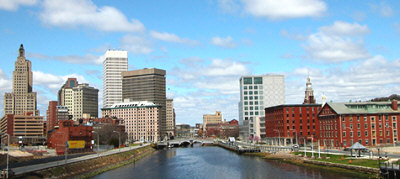Voters divided on mayor but satisfied with city services
October 6, 2011

Providence voters are nearly divided in their support for Mayor Angel Taveras, and a large majority — 86 percent — believe the city's economy is not recovering well from the economic recession, according to a recent public opinion survey conducted by the Taubman Center at Brown University. The survey was undertaken in conjunction with the annual Thomas J. Anton/Frederick Lippitt Urban Affairs Conference, scheduled for Thursday, Oct. 27, at Brown.
PROVIDENCE, R.I. [Brown University] — Mirroring the experience of residents in many other central cities across the country, 86 percent of Providence voters characterized the city’s economy as not so good or poor, according to a new Brown University survey. Yet, 46.9 percent of those surveyed said their personal economic situation has improved compared to one year ago, while 34.3 percent said their situation has worsened.
The survey was conducted Sept. 16-23, 2011, by researchers at the A. Alfred Taubman Center for Public Policy and American Institutions at Brown University. It is based on a citywide random sample of 435 registered voters in Providence. Overall, the poll had a margin of error of about plus or minus 4.7 percentage points. This survey was undertaken in conjunction with the Taubman Center’s annual Thomas J. Anton/Frederick Lippitt Urban Affairs Conference on “The Knowledge District: The Role of Universities and Medical Facilities in Urban Development,” on Thursday, Oct. 27, 2011, at 4 p.m. The conference is designed to explore the role of universities, medical facilities, and other “anchor” institutions in urban affairs.
The Taubman survey found President Barack Obama’s approval rating among Providence voters at 56 percent, several points higher than his rating in recent national polls. Mayor Angel Taveras’s approval rating among respondents is below Obama’s. Nearly 48 percent (47.9) of voters rated Taveras’s job performance as excellent or good, while 44 percent rated his performance as only fair or poor. A quarter of the respondents said they had a less favorable opinion of Taveras than they did 10 months ago at the start of his administration. Nearly 21 percent (20.9) said they had a more favorable opinion, and 44 percent said their opinion has remained the same. The survey asked about the recent decision by the Taveras administration to close four Providence public schools in order to save the city approximately $12 million. Nearly 56 percent (55.9) of the voters said they disagree or strongly disagree with the decision.
Providence voters reported that they are generally satisfied with public services in the city. For example, 79 percent said they were very satisfied or satisfied with garbage collection, about 64 percent (63.7) felt the same way about neighborhood police presence, nearly 89 percent (88.7) felt similarly about fire and ambulance service, and 60 percent replied similarly regarding parks in Providence. Respondents were most dissatisfied with Providence public schools and upkeep of roads throughout the city.
The survey also asked questions about the 20 acres of land around downtown that has opened due to the relocation of I-195. Many state and city leaders expect development of the land in the “Knowledge District” to attract high-wage, high-skilled job industries, including life sciences, health care, and research and development. The survey showed that nearly 68 percent (67.9) of registered voters in the city did not know much or anything about the Knowledge District. However, when told about the plan, the same number, nearly 68 percent, believed that the development of the district would help improve the city’s economy and attract businesses to Providence. A smaller percentage, 55 percent, believed the Knowledge District will provide jobs for people living in their neighborhood. Respondents in the survey were divided on whether the area should be renamed the Knowledge District or should continue as the “Jewelry District,” its historical name.

